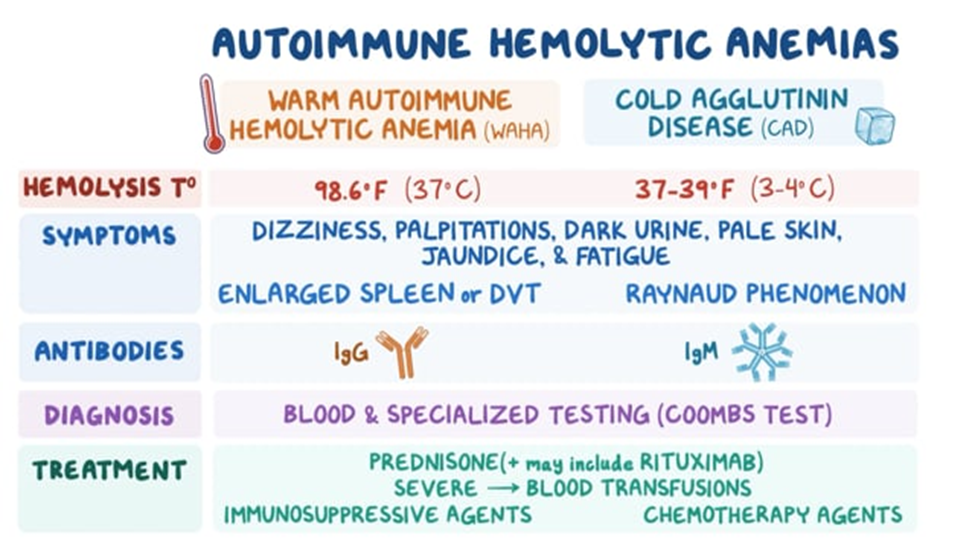A client comes into the clinic complaining of fatigue. Blood work shows an increased bilirubin concentration and an increased reticulocyte count. What would the nurse suspect the patient has?
Leukemia
Hemolytic anemia
Hypoproliferative anemia
Thrombocytopenia
The Correct Answer is B
A. Leukemia:
Explanation: Leukemia is a cancer of the blood-forming tissues, including the bone marrow and lymphatic system. It typically presents with an abnormal increase in white blood cells. While fatigue can be a symptom, increased bilirubin concentration and an increased reticulocyte count are not typical findings in leukemia.
B. Hemolytic Anemia:
Explanation: Hemolytic anemia is characterized by the premature destruction of red blood cells, leading to an increased release of bilirubin (from the breakdown of hemoglobin) and an increased reticulocyte count (as the body attempts to compensate by producing more red blood cells). This is a likely possibility given the presented symptoms.
C. Hypoproliferative Anemia:
Explanation: Hypoproliferative anemia is characterized by a decreased production of red blood cells. It is unlikely in this scenario, as an increased reticulocyte count suggests an attempt by the bone marrow to increase red blood cell production.
D. Thrombocytopenia:
Explanation: Thrombocytopenia is a condition characterized by a low platelet count. It does not typically present with an increased bilirubin concentration or an increased reticulocyte count.

Nursing Test Bank
Naxlex Comprehensive Predictor Exams
Related Questions
Correct Answer is A
Explanation
A. With the meal:
Insulin Lispro is a rapid-acting insulin that is designed to be taken just before or with meals.
It helps control the rise in blood sugar that occurs after eating.
B. Post-prandial:
"Post-prandial" refers to after a meal. Insulin Lispro is usually administered before or with a meal to cover the increase in blood glucose that happens after eating.
C. Pre-prandial:
"Pre-prandial" refers to before a meal. This is accurate for Insulin Lispro, as it is given shortly before or with meals.
D. AC/HS:
"AC" stands for "ante cibum," which means before meals, and "HS" stands for "hora somni," which means at bedtime. This terminology is more commonly associated with the timing of oral medications rather than insulin.
Correct Answer is A
Explanation
A. Respiratory acidosis:
This occurs when there is inadequate removal of carbon dioxide (CO2) by the respiratory system. In the case of the patient post-op from knee surgery receiving Morphine, the opioid can cause respiratory depression, leading to the retention of CO2 and the development of respiratory acidosis. Signs include a decreased respiratory rate and drowsiness.
B. Hypokalemia:
This is a condition characterized by low levels of potassium in the blood. While opioids can cause constipation, they are not directly associated with hypokalemia.
C. Metabolic acidosis:
This occurs when there is an increase in acid production or a loss of bicarbonate, leading to an imbalance in the body's acid-base status. The symptoms of metabolic acidosis are not typically associated with opioid use.
D. Respiratory alkalosis:
This occurs when there is excessive elimination of CO2, leading to decreased carbon dioxide levels in the blood. Opioids, especially in higher doses, are more likely to cause respiratory depression and acidosis rather than alkalosis. The patient's low respiratory rate and drowsiness are indicative of respiratory acidosis rather than alkalosis.
Whether you are a student looking to ace your exams or a practicing nurse seeking to enhance your expertise , our nursing education contents will empower you with the confidence and competence to make a difference in the lives of patients and become a respected leader in the healthcare field.
Visit Naxlex, invest in your future and unlock endless possibilities with our unparalleled nursing education contents today
Report Wrong Answer on the Current Question
Do you disagree with the answer? If yes, what is your expected answer? Explain.
Kindly be descriptive with the issue you are facing.
